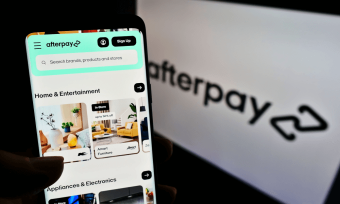Buy now pay later giant Afterpay also offers an Afterpay Card. The contactless Mastercard is stored in customers’ digital wallets, meaning Aussies can tap and pay when shopping with Afterpay in-store. Here’s how it works.
Key points:
- You can use the Afterpay app in-store with the Afterpay Card.
- New shoppers start with a lower shopping limit that can increase over time.
- Afterpay doesn’t charge interest, but you will face late fees if you miss a payment.
Shoppers can use the Afterpay app in-store by setting up an Afterpay Card. This allows you to pay for items over a short period of time rather than paying the full amount up front.
But what exactly is it and how does it work?
How does the Afterpay Card work?
The Afterpay Card is a buy now pay later (BNPL) system that allows customers to shop in-store using their digital wallet and a contactless payment device.
The payment structure for customers using the Afterpay Card is the same as for other Afterpay payment methods. Repayments on purchases are made up of four equal, fortnightly instalments starting at the time of purchase, with late fees charged for customers who miss a payment.
How do you set up Afterpay Card?
You can set up the Afterpay Card through the Afterpay app. As part of this, you’ll need to add your Afterpay Card to your Apple Wallet, Google Pay or Samsung Pay.
How do you make a purchase with the Afterpay Card?
When you’re ready to make an in-store purchase with Afterpay, you can go to your phone’s e-wallet, select the Afterpay Card, and tap on a contactless payment device. Afterpay is not accepted at all stores.
How much can I spend on an Afterpay Card?
According to Afterpay spending limits start at around $600. New shoppers start with a lower shopping limit that increases over time if you have a good payment history.
You will be shown an estimated amount you can spend when you log into the Afterpay app.
Outstanding payments and the numbers of payments you have ‘open’ can impact your ability to make another purchase.
If you miss a payment you won’t be able to make another purchase and your spending limits might even decrease.
What are the fees with an Afterpay Card?
Afterpay doesn’t charge interest, but you will face late fees if you miss a payment.
Afterpay says it has a 25% capped late fee (never exceeding more than $68 per order) which is applicable across all orders, regardless of the order amount.
There are no fees for customers who pay on time.
Where can I use the Afterpay Card?
The Afterpay Card can only be used at stores that offer Afterpay. You can find a list of participating stores in the Afterpay app or on its website.
This is a different system to some of Afterpay’s competitors, such as Zip and CommBank. Zip has a partnership with Visa whereby customers can use Zip Pay wherever there is a contactless symbol, rather than just at affiliated retailers. Likewise, CommBank says customers can use its BNPL card wherever Mastercard is accepted.
While the Afterpay Card may make it more convenient for some people to use the service, there may be more to consider for people who are already struggling to get their BNPL spending in check.
Is Afterpay the right payment option for me?
If you already use Afterpay or another BNPL service, or you are thinking about using one, you might want to compare your options. Before committing to a particular service, it could be wise to consider any fees and charges involved, as well as whether using a BNPL service is the right option for you.
A report by the Australian Finance Industry Association released in June 2022 found there were 5.9 million active BNPL accounts in Australia.
Fifty-four percent of people surveyed said they prefer BNPL over credit cards because they pay no interest and it helps them manage their cashflow.
But one in 23 respondents said they went without ‘essentials’ to make BNPL repayments.
Cover image source: monticello/Shutterstock.com
This content was reviewed by Deputy Editor, Canstar Amanda Horswill as part of our fact-checking process.







Share this article